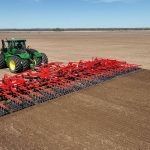
Tag Archives crop residue

Kuhn introduces the 5640 field cultivator
Wider 56- and 60-foot working widths introduced

Restore productivity on your eroded knolls
Landscape restoration, cover cropping, residue redistribution and adjusting crop inputs are some management practices that can help

Retain your rain
Farmers can get creative to manage water efficiency on Prairie fields

Research confirms value of taller crop stubble
Technology is available to help set up, measure and monitor on-farm research projects

Strip tillage reducing erosion risk
For this Alberta farmer, the practice is one tool to protect vulnerable crops from the blast of prevailing winds

Opposing exposure to erosion
Early indications in Alberta research are that soil stays put, with no adverse effect on crop performance

Do your homework on alternative feeds
What looks to be another dry year will mean added emphasis on byproduct feeds

Drought preparedness through soil and crop management
After each dry year, adapt your drought plan based on your experiences and what you learned

Curb risk from moisture stress for less
A Manitoba agronomist offers up some tips for farmers on a budget

Crop residues’ rewards versus risks
Leaving crop residue after harvest can be beneficial — but poses some challenges


